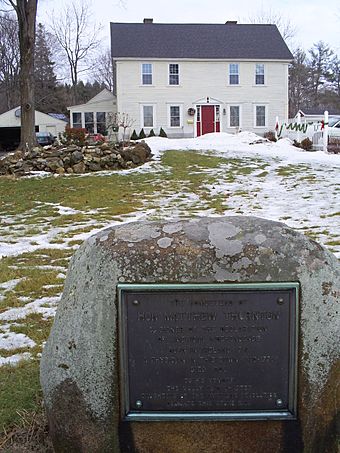Matthew Thornton House facts for kids
|
Matthew Thornton House
|
|

The Matthew Thornton House
|
|
| Location | 2 Thornton Street, Derry Village, New Hampshire |
|---|---|
| Area | 2.5 acres (1.0 ha) |
| Architectural style | Greek Revival, Colonial |
| NRHP reference No. | 71000053 |
Quick facts for kids Significant dates |
|
| Added to NRHP | November 11, 1971 |
| Designated NHL | November 11, 1971 |
The Matthew Thornton House is a really old and important house in Derry, New Hampshire. It was the home of Matthew Thornton from 1740 to 1779. He was a very special person because he signed the Declaration of Independence! This house is so important that it's been named a National Historic Landmark.
Contents
The Matthew Thornton House: A Historic Home
What Does the House Look Like?
The main part of the Matthew Thornton House looks like a classic New England saltbox home. It has a square shape with a steeply sloped roof at the back. Imagine a house that's five windows wide and two windows deep.
Later, in the 1800s, some new fancy details were added. These included wide, flat columns called pilasters at the corners of the house. A small porch, or portico, was also added to cover the front door. The windows on the first floor have decorative tops, like little crowns.
Inside the Historic House
A single-story wing, or ell, sticks out from the back of the house. This part was built to hold a more modern kitchen and rooms for servants. The main part of the house has a typical layout with a hallway in the middle. There are four rooms on each floor. The chimneys were changed in the 1800s to be smaller.
Why is This House Important?
The Matthew Thornton House is a very special place in American history. It was the home of Matthew Thornton for nearly 40 years. Because of its connection to him, the house was made a National Historic Landmark in 1971. It is also listed on the National Register of Historic Places.
Who Was Matthew Thornton?
Matthew Thornton's Early Life and Career
Matthew Thornton was born in Ireland, probably in 1714. He moved to North America with his parents in 1718 when he was just a little kid. He decided to become a doctor and started his medical practice in Derry in 1740.
Matthew Thornton's Role in Politics
Thornton became involved in New Hampshire politics in 1758. He served in the state assembly until 1775. That year, a new temporary government took over. Thornton helped write a new constitution for the state.
Signing the Declaration of Independence
In 1776, Matthew Thornton was chosen to be part of the Second Continental Congress. This was a very important group of leaders from the American colonies. Even though he didn't officially start his job until November 1776, he still signed the Declaration of Independence. This document declared America's freedom from Great Britain.
Later Life and Legacy
In 1780, Matthew Thornton moved to Merrimack, New Hampshire. He continued to be active in state politics there. He passed away in 1803. Matthew Thornton is buried in the Signer's Cemetery, which is near his home in Merrimack. This cemetery and his Merrimack house are also recognized as historic places.



